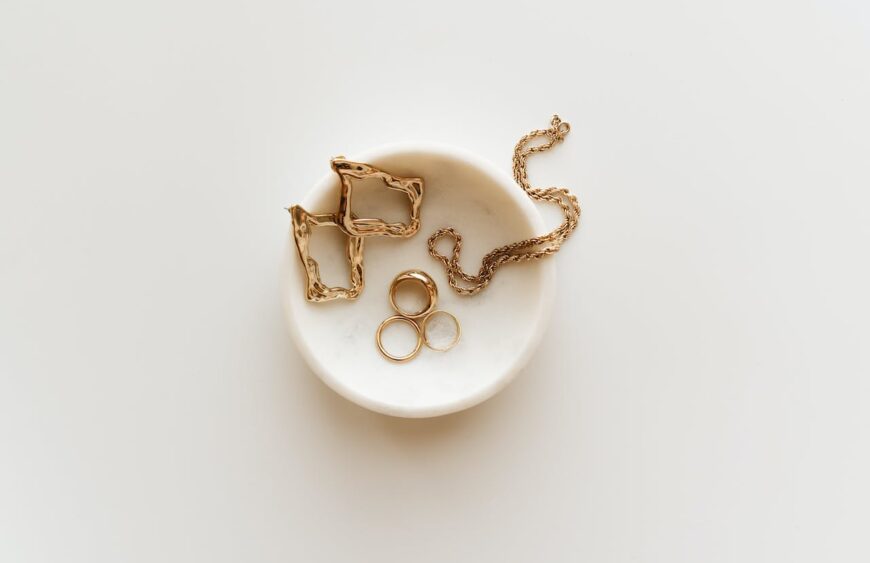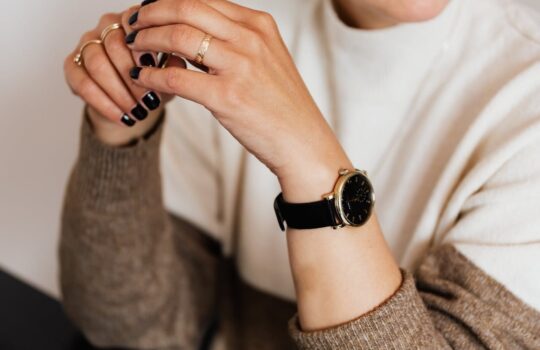Navigating the world of gold jewelry can be overwhelming, leaving you frustrated and puzzled, especially if you’ve experienced your favorite piece leaving marks behind. Here at Haute Haus, we specialize in jewelry designed for everyday wear. To demystify your shopping experience, let’s delve into the distinctions among:
- Gold-Plated Jewelry
- PVD Gold Jewelry
- Gold Vermeil Jewelry
- Gold-Filled Jewelry, and
- Solid Gold Jewelry
Types of Gold Jewelry Explained
Here are the different types of gold jewelry – explained!
I. What is Gold Plated Jewelry?
Gold-plated jewelry consists of an ultra-thin layer of gold—typically 0.05% actual gold or even less—coated onto a base metal, often brass or copper. This thin layer of gold is applied to the base metal to give it the appearance of solid gold, creating what we know as gold-plated jewelry.
Due to its ultra-thin layer, gold plating is susceptible to wear and tear, with the gold easily rubbing off over time. It’s also more prone to tarnishing when exposed to liquids or chemicals. While gold itself doesn’t corrode, the base metals like copper and brass underneath it can, especially when in contact with substances like sweat, lotion, or perfume. Gold-plated jewelry is significantly cheaper than other types of gold jewelry since it only uses a small amount of gold layered onto a base metal. It’s a practical choice for occasional wear or experimenting with new fashion trends.

II. What is PVD Gold Plated Jewelry?
PVD gold jewelry involves bonding stainless steel with a thin layer of gold through a process called physical vapor deposition (PVD).
This method can use either real gold or a gold-colored substance. PVD ensures the gold layer remains resistant to water damage, sweat, and scratches over many years, making it suitable for everyday wear. While we advise against sleeping with jewelry on for safety reasons, PVD jewelry’s stainless steel base won’t cause skin reactions. Despite its thinner gold layer, PVD offers a hue similar to, if not identical to, that of solid gold or vermeil jewelry.
PVD Gold Jewelry is an excellent option for daily wear, providing the same look as pricier alternatives at a more affordable cost. With proper care, PVD gold jewelry can last several years. Though we still discourage swimming or sleeping with jewelry on, PVD pieces offer more resistance to chlorine damage if you happen to take a dip in the pool while wearing them.

III. What is Gold Vermeil Jewelry?
Gold vermeil, pronounced “ver-may,” consists of a generous 2.5 microns of gold plating layered onto sterling silver. This jewelry is hypoallergenic, making it safe for those with metal sensitivities. Unlike regular gold plating, gold vermeil lasts significantly longer due to its thicker plating. However, with prolonged wear, especially in high-contact areas, the gold layer may eventually wear off over time.
Because the base metal of gold vermeil is sterling silver, it can tarnish if left exposed without proper care. Regularly sealing it in an airtight bag can prevent tarnishing, but if it does occur, a simple polishing cloth can easily restore its shine. Treat your gold vermeil pieces like you would sterling silver jewelry.

IV. What is Gold-Filled Jewelry?
Gold-filled jewelry involves a solid layer of gold that’s mechanically bonded to a base metal, typically jeweler’s brass. According to US standards, this gold layer must make up 1/20th (or 5%) of the jewelry’s total weight. Gold-filled pieces can be crafted with either 14k or 12k gold, with 14k being the more prevalent option. While some pieces may bear a marking like “1/20 14K GF” or “1/20 14K,” not all are necessarily labeled as such.
Gold-filled jewelry boasts nearly 100 times more gold than its plated counterpart. Unlike gold-plated jewelry, where the gold is merely coated on the surface, gold-filled pieces feature gold that’s mechanically bonded to the base metal, ensuring it won’t rub off. With qualities akin to solid gold jewelry but at a fraction of the cost, gold-filled pieces are both tarnish-resistant and waterproof, making them perfect for everyday wear. Additionally, they’re a safe choice for those with metal allergies, as they won’t trigger any adverse reactions.
However, due to its manufacturing process, gold-filled jewelry is limited to wire or sheet forms and cannot be casted or molded. Charms may either be flat, crafted from sheets, or hollow, made by soldering two pieces of sheet metal together. When charms or rings can’t be made from gold-filled material, we opt for gold vermeil instead.

V. What is Solid Gold Jewelry?
Solid gold jewelry represents the pinnacle of quality, with the entire piece crafted entirely from gold without any base metal. Gold comes in various karats, indicating the proportion of pure gold versus alloy metals. While pure gold (24k) is too soft for everyday wear, lower karats like 14k (58.3% gold, 41.7% alloys) and 18k (75% gold, 25% alloys) offer both strength and durability.
Here are the different karats of gold you will find when shopping for solid gold jewelry:
- 24k gold is pure gold but it’s too soft for daily use. It has a deep orange color. Stamped as 999.
- 18k gold is 75% gold, stamped as 750.
- 14k gold is 58.3% gold, stamped as 585.
- 9k gold is 37.5% gold, stamped as 375.
Solid gold jewelry is exceptionally resistant to tarnishing, hypoallergenic, and ideal for daily wear, making it perfect for those with sensitive skin. It’s a precious metal renowned for its longevity, capable of becoming treasured heirlooms passed down through generations. If you’re seeking a timeless piece that can be cherished for a lifetime and beyond, solid gold is the material of choice.
What’s Best for Me?
The ideal choice of gold jewelry depends on several factors, including your budget, frequency of wear, and maintenance capabilities. For unparalleled quality and longevity, solid gold reigns supreme, capable of lasting generations. However, if affordability is a concern, options like gold-filled and gold vermeil offer hypoallergenic, waterproof, and durable alternatives suitable for everyday wear.
We hope this information sheds light on the various gold options available out there. Feel free to share your thoughts in the comments or reach out with any questions. We’re here to help!






Jenny Ngugi
5 November 2024 at 22:25Thanks for this. Much-needed clarity.